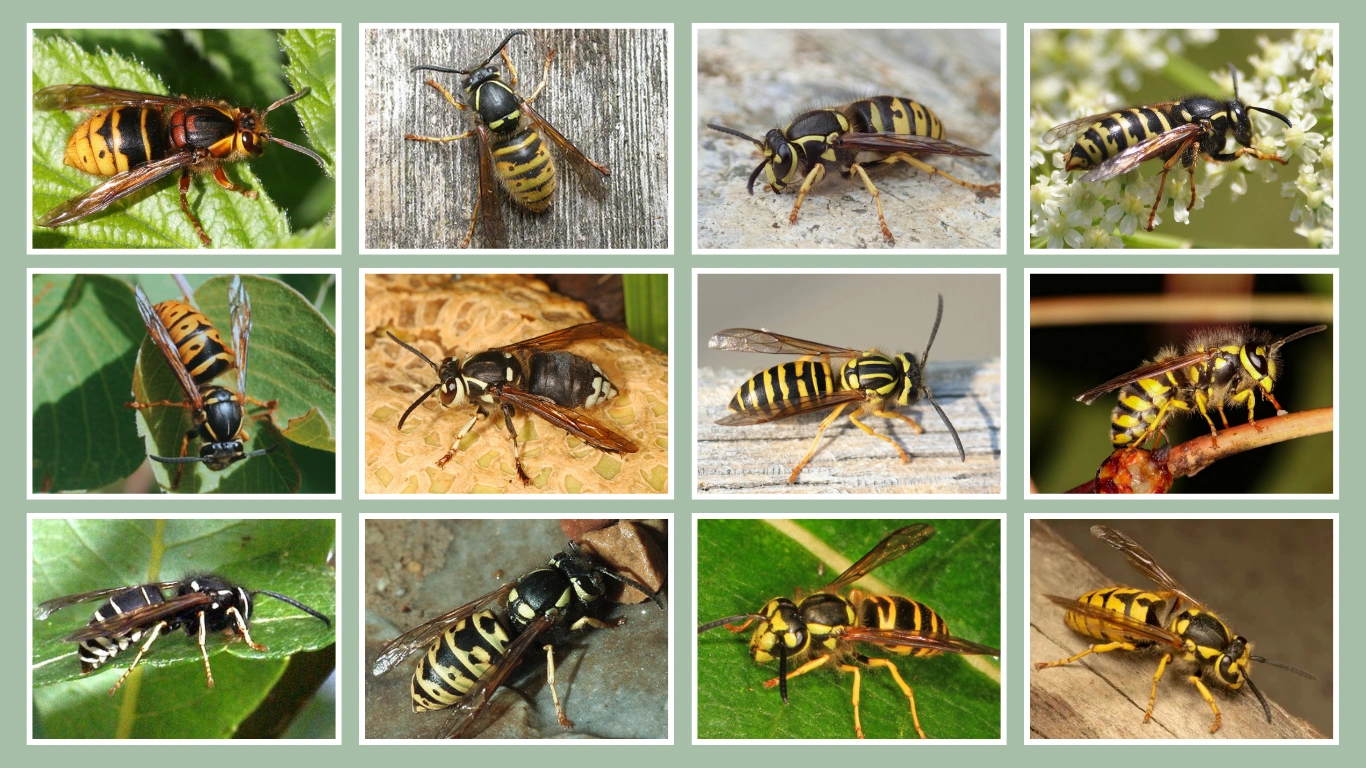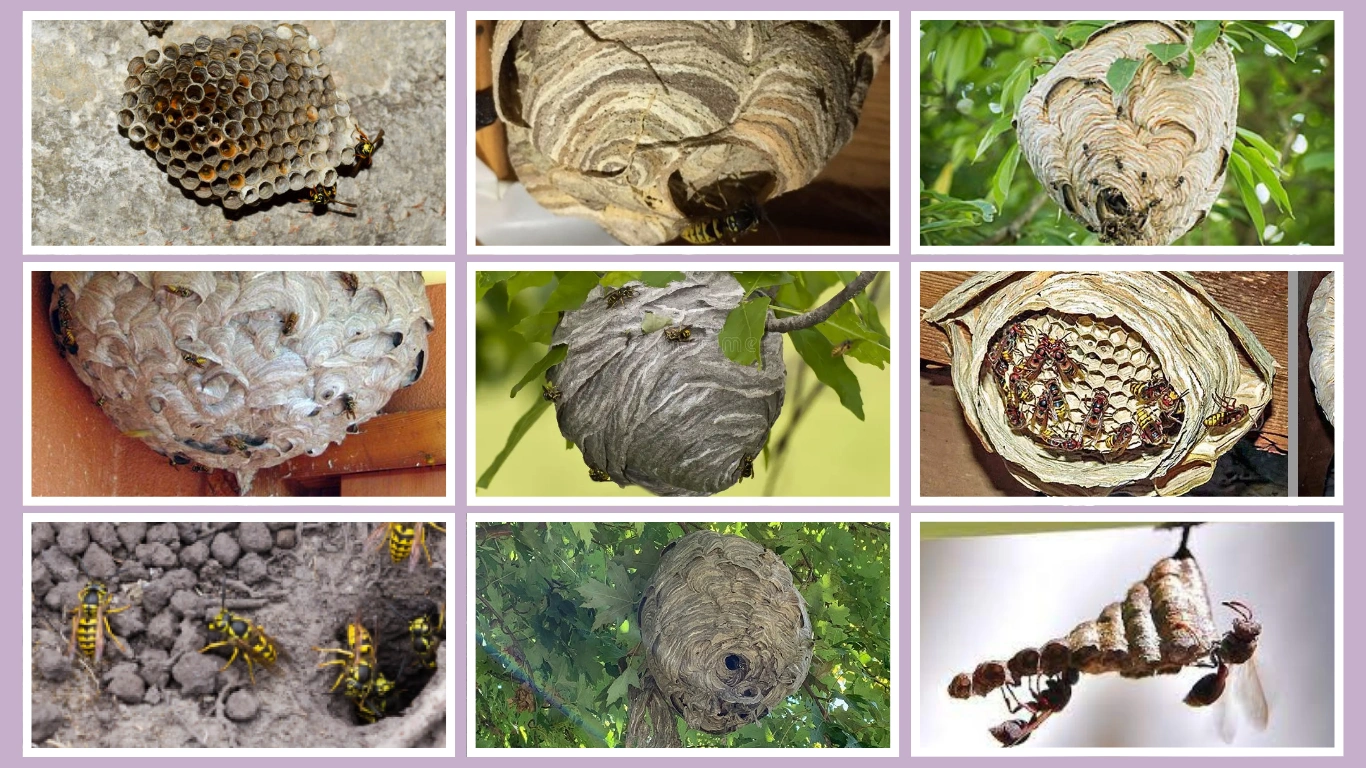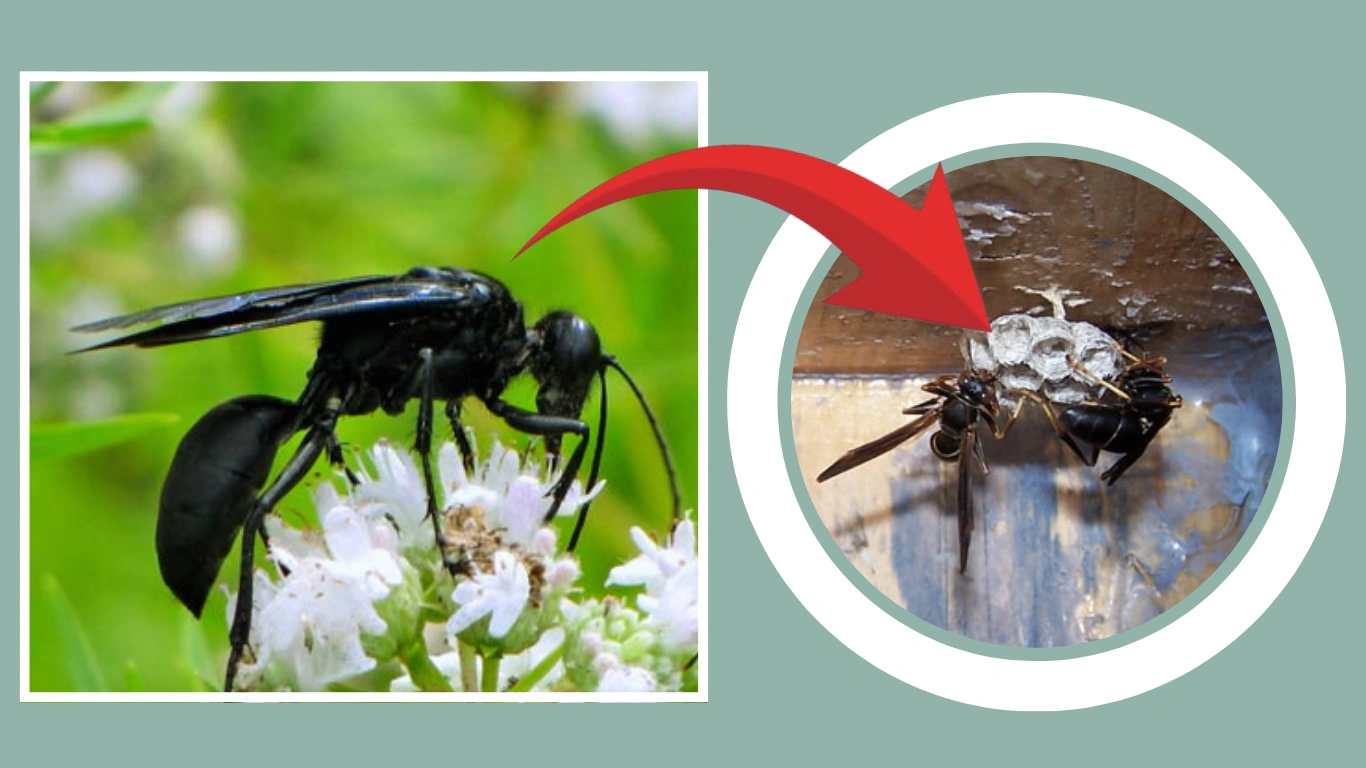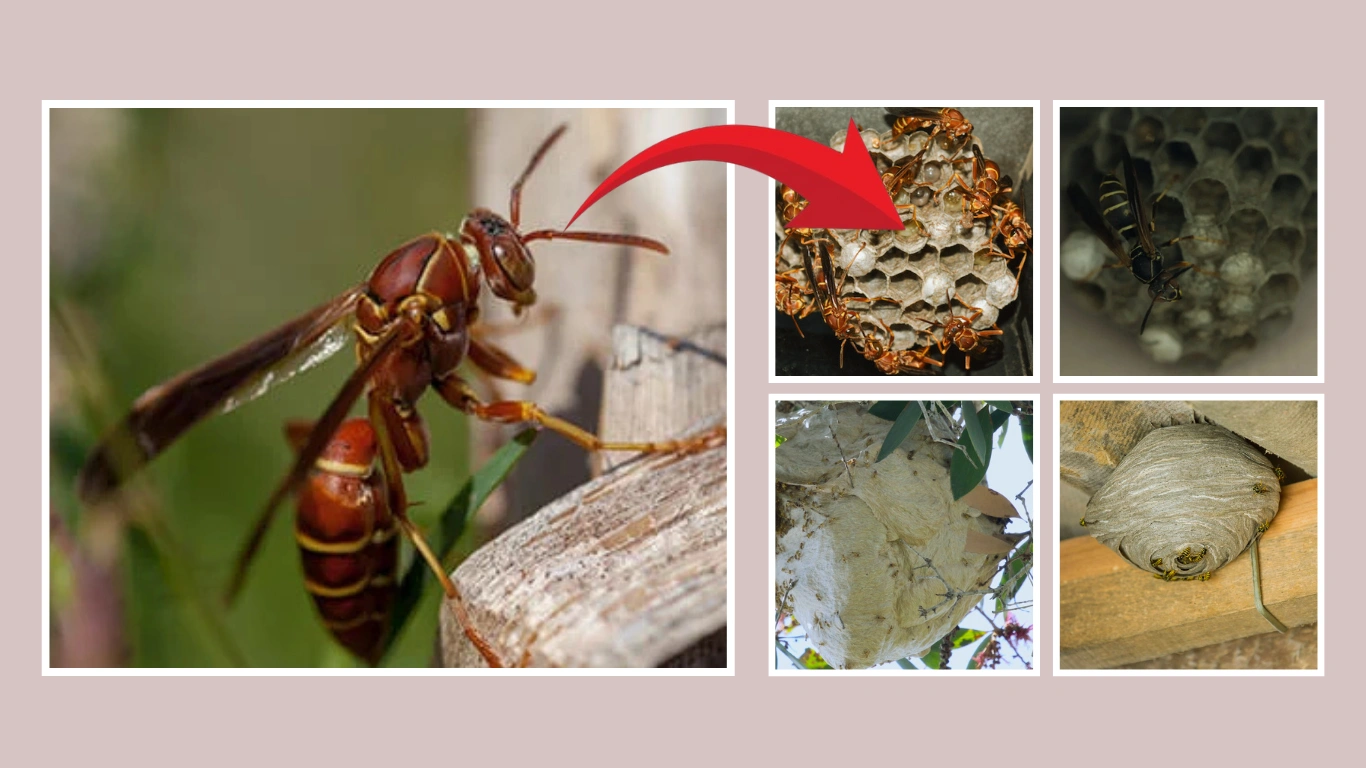Yellow jacket wasps are fast, aggressive, and often misunderstood insects that come in various species across the globe. From ground-dwelling Vespula to aerial-nesting Dolichovespula, each type has unique traits and behaviors. In this guide, you’ll discover all known types of yellowjackets with detailed identification tips, nesting habits, and sting risks—perfect for gardeners, homeowners, or anyone curious about these buzzing defenders.
1. Vespula vulgaris – Common Yellowjacket
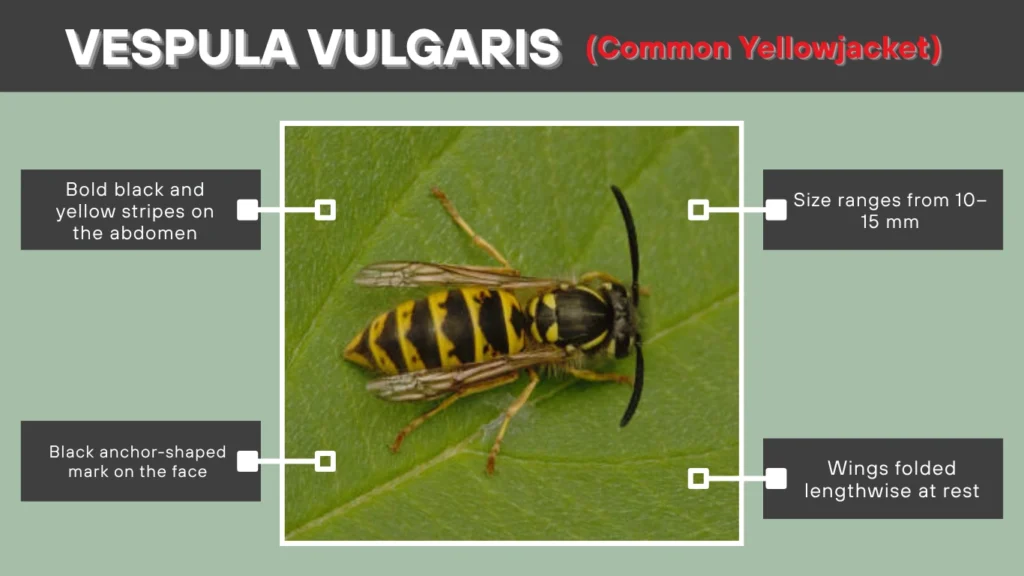
The Common Yellowjacket (Vespula vulgaris) is a widespread and aggressive species found across Europe and in parts of North America. Known for its distinct black and yellow body and painful sting, this wasp often nests underground and is notorious for scavenging sugary foods during late summer.
Identification
- Bold black and yellow stripes on the abdomen
- Black anchor-shaped mark on the face
- Size ranges from 10–15 mm
- Wings folded lengthwise at rest
- More compact and stocky than other wasps
Behavior and Nesting
Common Yellowjackets usually build nests underground or in hidden cavities like wall voids or attics. The colonies grow rapidly in summer, and the wasps become more aggressive in late summer and early fall as food becomes scarce.
Sting Risk and Aggression
They are highly defensive around their nests and can sting multiple times. Stings are painful and may cause allergic reactions in sensitive individuals. This species is a common culprit behind late-summer wasp stings at picnics and outdoor events.
2. German Yellowjacket (Vespula germanica)
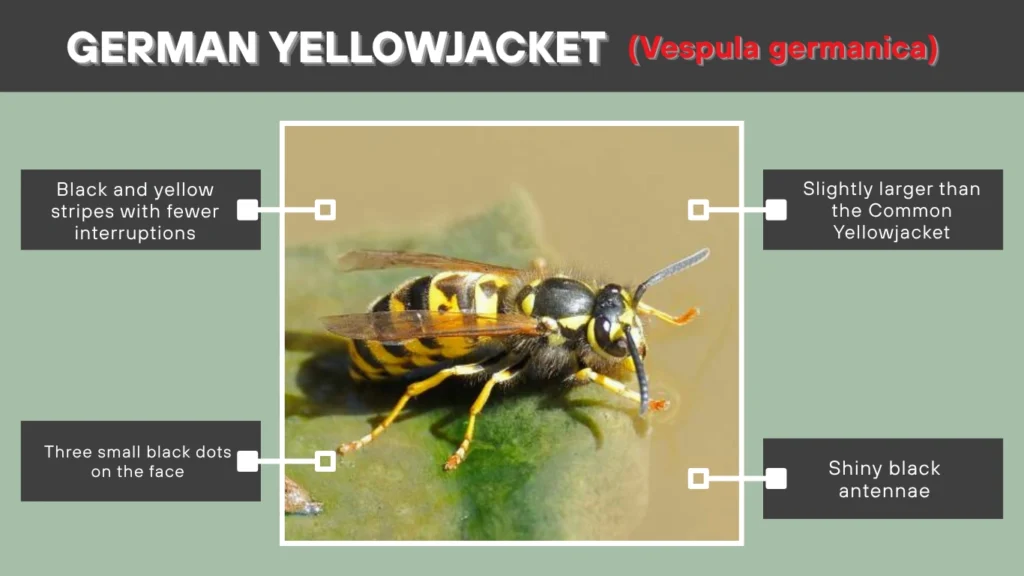
The German Yellowjacket is a highly adaptable and invasive species found across Europe, North America, Australia, and New Zealand. It thrives in urban and rural environments, often nesting in buildings, wall cavities, and underground spaces.
Identification
- Black and yellow stripes with fewer interruptions
- Three small black dots on the face
- Slightly larger than the Common Yellowjacket
- Shiny black antennae
- Clear wings with dark margins
Behavior and Nesting
German Yellowjackets are known for nesting inside structures, creating large, hidden colonies. They become very aggressive in late summer and are frequent scavengers of human food.
Sting Risk and Aggression
This species can sting repeatedly and is one of the most commonly reported stingers in urban areas. Their presence often increases human-wasp conflicts, especially near trash bins and food sources.
3. Western Yellowjacket (Vespula pensylvanica)
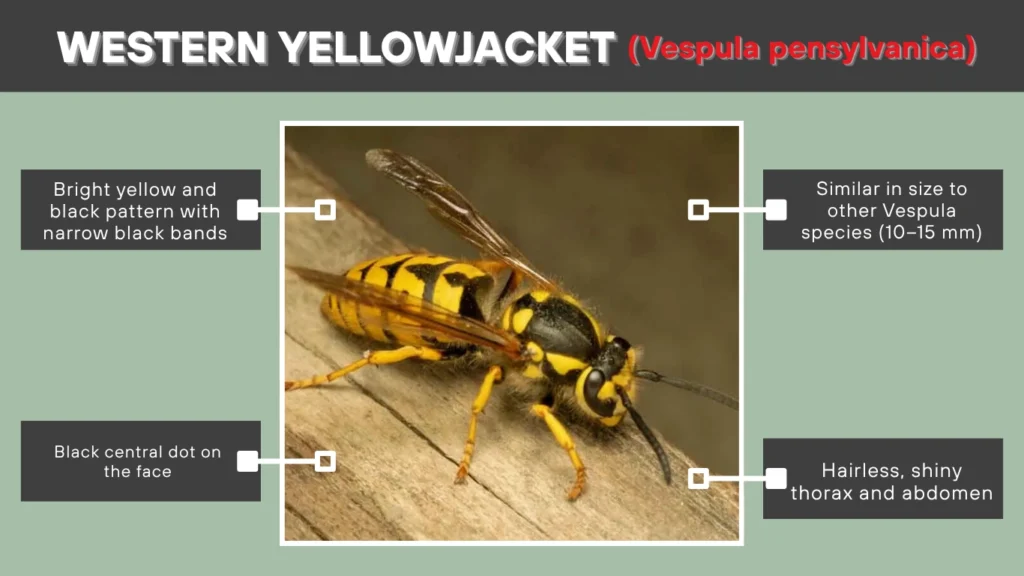
The Western Yellowjacket is native to the western United States and Canada. It is a dominant scavenger species, often found near outdoor food sources during the warmer months.
Identification
- Bright yellow and black pattern with narrow black bands
- Black central dot on the face
- Similar in size to other Vespula species (10–15 mm)
- Hairless, shiny thorax and abdomen
- Rapid and erratic flight pattern
Behavior and Nesting
They usually nest underground or in wall voids. Their colonies grow aggressively, and they are one of the top nuisance species in the western U.S., often invading parks, campsites, and outdoor eating areas.
Sting Risk and Aggression
Western Yellowjackets are known for repeated stinging and defensive behavior near their nests. They are major contributors to wasp sting incidents in their range and are highly attracted to sugary foods and drinks.
4. Eastern Yellowjacket (Vespula maculifrons)

The Eastern Yellowjacket is commonly found in the eastern United States and parts of Canada. It prefers forested and suburban areas, often nesting underground or in hidden cavities.
Identification
- Bright yellow and black markings
- Anchor-shaped black mark on the first abdominal segment
- Yellow face with a single black dot
- Slightly smaller than some other Vespula species
- Smooth, shiny body
Behavior and Nesting
They build subterranean nests, often in abandoned rodent burrows. Colonies can grow large and may persist into the fall. They forage aggressively and are frequent intruders at picnics and garbage areas.
Sting Risk and Aggression
Eastern Yellowjackets will defend their nests fiercely. Their sting is painful and can trigger allergic reactions, particularly during late summer when their activity peaks.
5. Alaskan Yellowjacket (Vespula alascensis)

The Alaskan Yellowjacket was once confused with the Eastern Yellowjacket but is now recognized as a separate species. It is found throughout Alaska, Canada, and parts of the northern United States.
Identification
- Similar black and yellow pattern to Vespula maculifrons
- Black facial markings may vary slightly
- Robust body shape
- Clear wings and black antennae
- Moderate size (10–14 mm)
Behavior and Nesting
They typically nest underground but are also found in wall voids and logs. They are active throughout the summer and early fall, scavenging for sweets and proteins.
Sting Risk and Aggression
Though not as aggressive as some other yellowjackets, they will sting in defense. Repeated stings are possible, and nests disturbed by humans or animals may provoke an aggressive swarm.
6. Forest Yellowjacket (Vespula acadica)
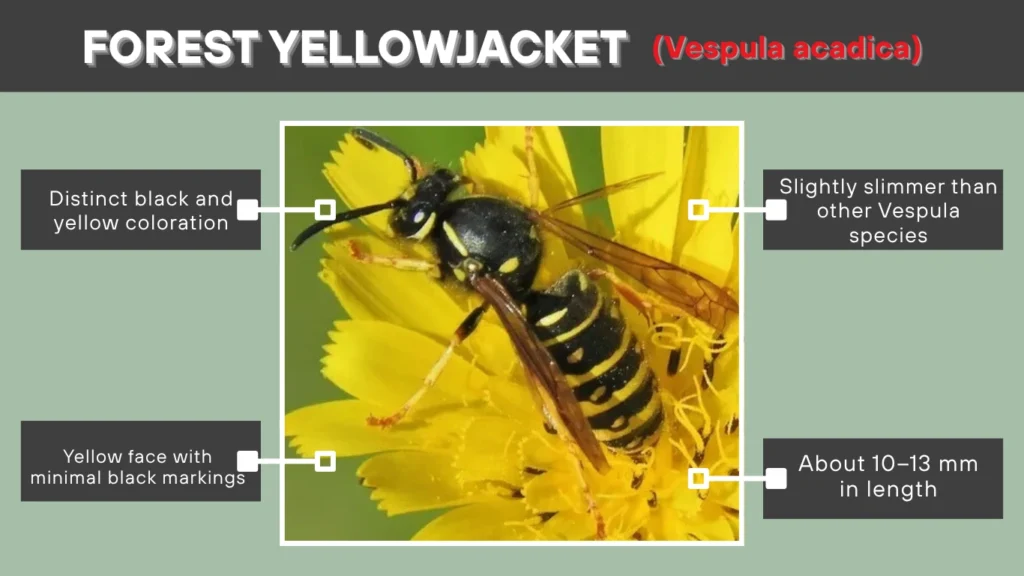
The Forest Yellowjacket is a lesser-known species primarily found in forested regions of the northeastern United States and Canada. It tends to avoid urban areas and is less commonly encountered by humans.
Identification
- Distinct black and yellow coloration
- Yellow face with minimal black markings
- Slightly slimmer than other Vespula species
- Wings fold lengthwise when at rest
- About 10–13 mm in length
Behavior and Nesting
They usually build underground nests in wooded or shaded areas. Colonies are smaller compared to more aggressive species and rarely forage far from the nest.
Sting Risk and Aggression
Forest Yellowjackets are less aggressive unless their nest is directly disturbed. Their sting is painful, but encounters with humans are infrequent due to their remote habitat preference.
7. Prairie Yellowjacket (Vespula atropilosa)
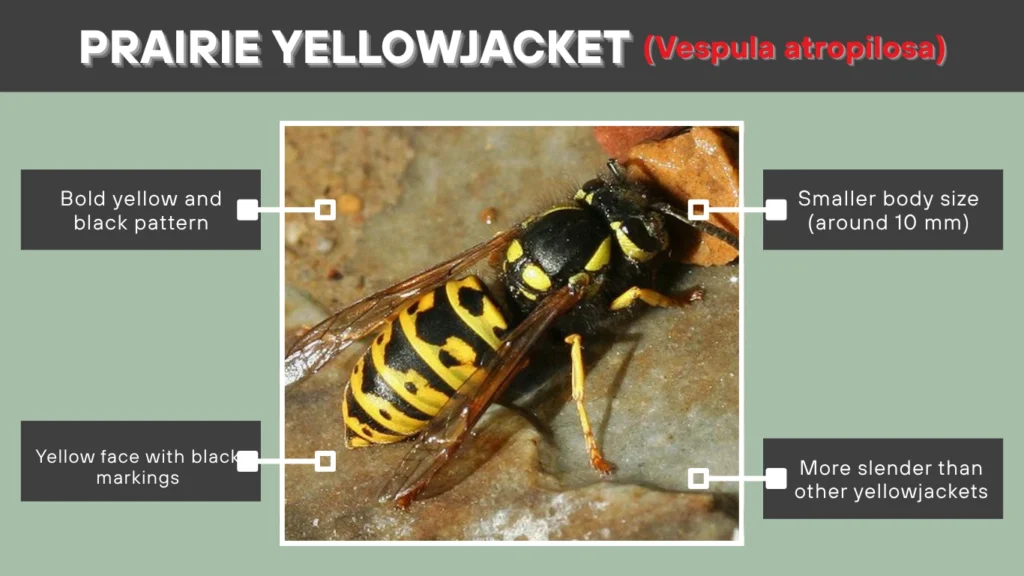
The Prairie Yellowjacket is native to open grasslands and prairie regions of North America. It plays a helpful ecological role by feeding primarily on live prey like insects rather than scavenging human food.
Identification
- Bold yellow and black pattern
- Yellow face with black markings
- Smaller body size (around 10 mm)
- More slender than other yellowjackets
- Narrow bands on the abdomen
Behavior and Nesting
They typically nest in the ground and prefer dry, open habitats. Colonies are moderate in size and focus on hunting live insects rather than scavenging.
Sting Risk and Aggression
They are generally not aggressive toward humans unless the nest is threatened. Their sting is still potent and can cause pain or allergic reactions in sensitive individuals.
8. Black-jacket Wasp (Vespula consobrina)
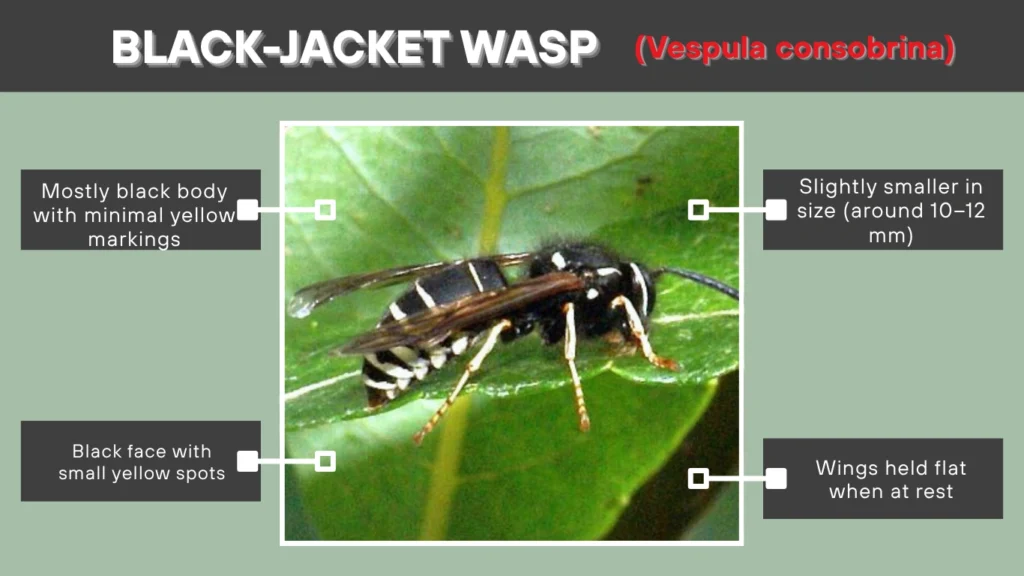
The Black-jacket Wasp is a striking species found in Canada and the northern United States. Its darker appearance sets it apart from the typical yellowjackets.
Identification
- Mostly black body with minimal yellow markings
- Yellow bands are narrow and restricted to the abdomen
- Black face with small yellow spots
- Slightly smaller in size (around 10–12 mm)
- Wings held flat when at rest
Behavior and Nesting
Black-jacket Wasps prefer forested and mountainous areas. They build underground nests, often in shaded, undisturbed environments. Colonies are usually smaller and less aggressive.
Sting Risk and Aggression
They are not highly aggressive but will defend their nest if disturbed. Their sting is painful, though encounters with humans are rare due to their remote habitat.
9. Downy Yellowjacket (Vespula flavopilosa)
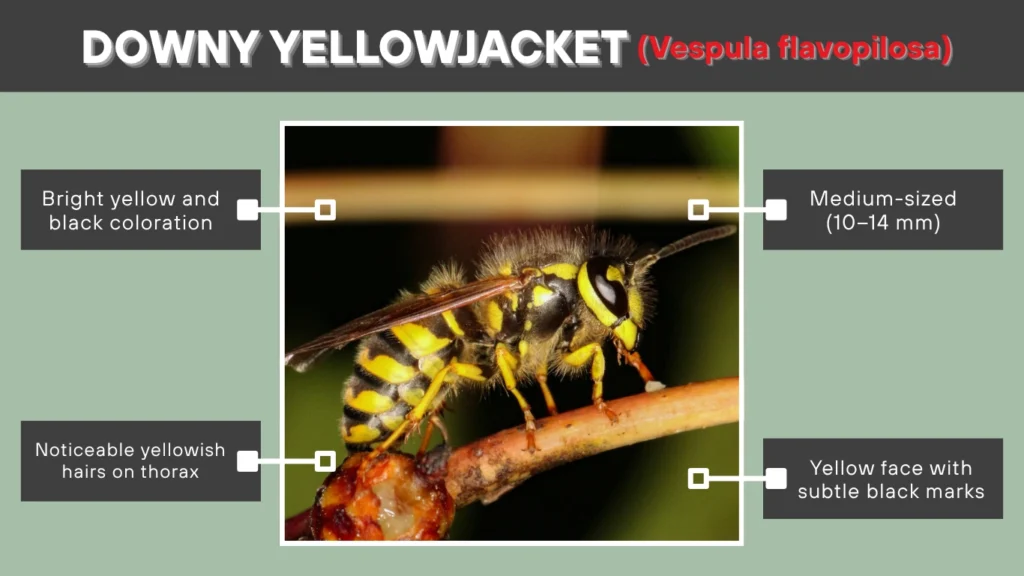
The Downy Yellowjacket is a rare species in North America, recognized by the fine yellow hairs on its thorax.
Identification
- Bright yellow and black coloration
- Noticeable yellowish hairs on thorax
- Medium-sized (10–14 mm)
- Yellow face with subtle black marks
- Slightly fuzzy appearance compared to other yellowjackets
Behavior and Nesting
This species nests underground, often in undisturbed grassy areas. It has a short active season and is less frequently seen than other Vespula wasps.
Sting Risk and Aggression
Downy Yellowjackets are not known for aggression but will sting if provoked. Due to their limited range and rarity, human interactions are uncommon.
10. Southern Yellowjacket (Vespula squamosa)

The Southern Yellowjacket is a highly aggressive species found in the southeastern United States. It is known for forming massive colonies that may persist year-round in warm climates.
Identification
- Bright yellow with bold black markings
- Orange or reddish tint on some abdominal bands
- Yellow face with black central stripe
- Slightly larger than average yellowjackets (12–15 mm)
- Strong, stocky build
Behavior and Nesting
They usually nest underground but are also found in wall voids and debris piles. In southern regions, perennial nests can contain thousands of workers and multiple queens.
Sting Risk and Aggression
Extremely aggressive near the nest and known for rapid swarming. Stings are painful and can be life-threatening to those with allergies. Caution is strongly advised near suspected nests.
11. Bald-faced Hornet (Dolichovespula maculata)
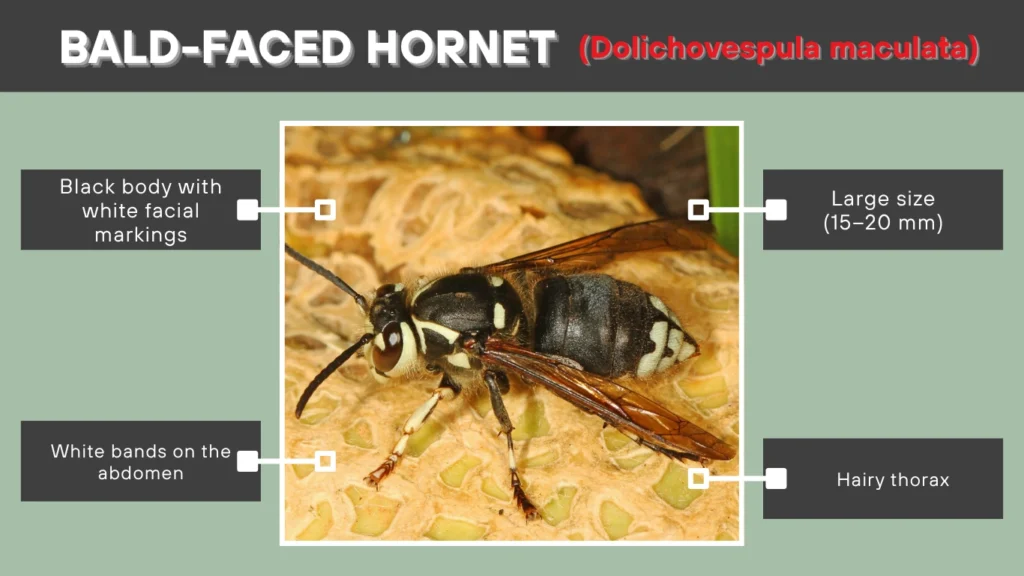
Though called a hornet, the Bald-faced Hornet is technically a yellowjacket species. It is common in North America and recognized for its large, aerial paper nests.
Identification
- Black body with white facial markings
- White bands on the abdomen
- Large size (15–20 mm)
- Hairy thorax
- Loud and intimidating buzz
Behavior and Nesting
They build large, round nests in trees, shrubs, or under eaves. These wasps are highly protective of their colony and will aggressively defend it when disturbed.
Sting Risk and Aggression
Bald-faced Hornets deliver powerful stings and may chase threats for several meters. Their venom can cause significant swelling and allergic reactions in sensitive individuals.
12. Aerial Yellowjacket (Dolichovespula arenaria)

The Aerial Yellowjacket is one of the few yellowjacket species that consistently builds exposed, above-ground nests. It is found throughout North America, particularly in forested and suburban areas.
Identification
- Yellow and black markings with a wasp-like appearance
- Yellow face with black central mark
- Slightly longer and slimmer than ground-nesting Vespula species
- 12–16 mm in length
- Legs often appear yellow during flight
Behavior and Nesting
They build large, gray paper nests in trees, on buildings, or under overhangs. Colonies are seasonal and often less aggressive than their ground-nesting relatives.
Sting Risk and Aggression
Generally less aggressive unless the nest is disturbed. However, their sting is still painful and potentially dangerous to those with allergies.
13. Parasitic Yellowjacket (Dolichovespula adulterina)
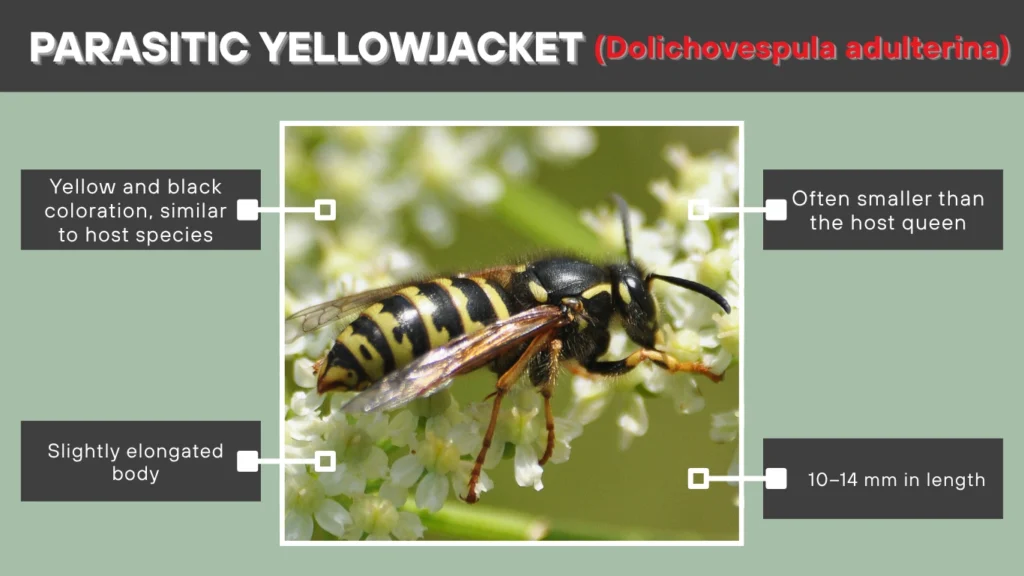
The Parasitic Yellowjacket is a rare, brood-parasitic species that doesn’t build its own nests. Instead, it invades the colonies of other Dolichovespula wasps to lay eggs.
Identification
- Yellow and black coloration, similar to host species
- Slightly elongated body
- Often smaller than the host queen
- 10–14 mm in length
- Subtle differences in facial markings from other yellowjackets
Behavior and Nesting
Instead of building a nest, the female invades a host colony, kills or subdues the queen, and lays her eggs. The host workers unknowingly raise the parasitic offspring.
Sting Risk and Aggression
Rarely encountered by humans and not aggressive unless handled. Their unusual lifestyle makes stings from this species extremely uncommon.
14. Norwegian Yellowjacket (Dolichovespula norvegicoides)
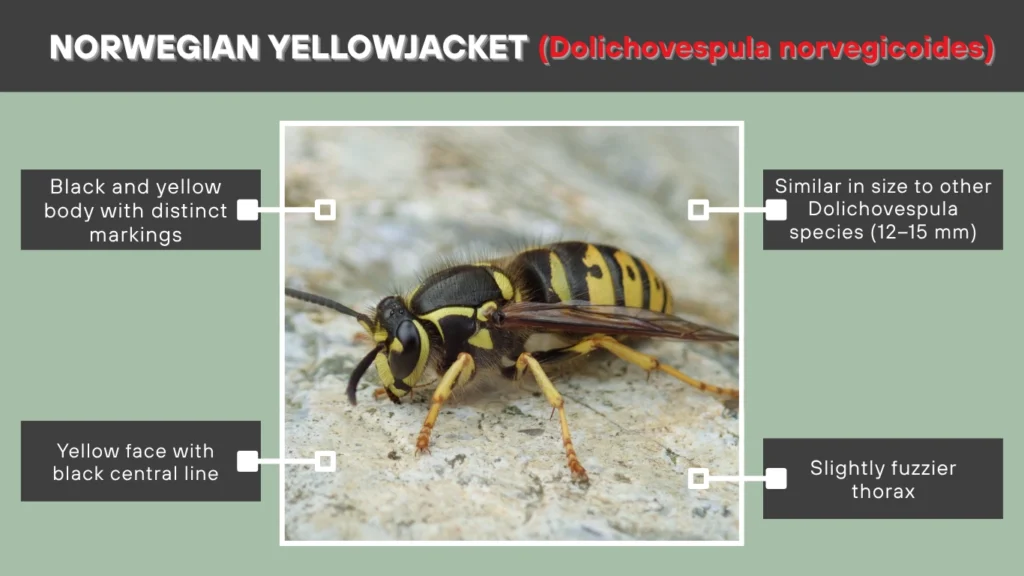
The Norwegian Yellowjacket is found mainly in the northern United States and Canada, especially in cooler, forested regions. It is closely related to the European Dolichovespula norwegica.
Identification
- Black and yellow body with distinct markings
- Yellow face with black central line
- Similar in size to other Dolichovespula species (12–15 mm)
- Slightly fuzzier thorax
- Narrow black bands on the abdomen
Behavior and Nesting
This species builds aerial nests in trees, shrubs, and under eaves. It prefers remote or wooded locations and is active in cooler climates during summer.
Sting Risk and Aggression
Less aggressive than other yellowjackets but will defend its nest if disturbed. Their sting is painful, though attacks are infrequent due to their reclusive nesting habits.
15. Saxon Yellowjacket (Dolichovespula saxonica)
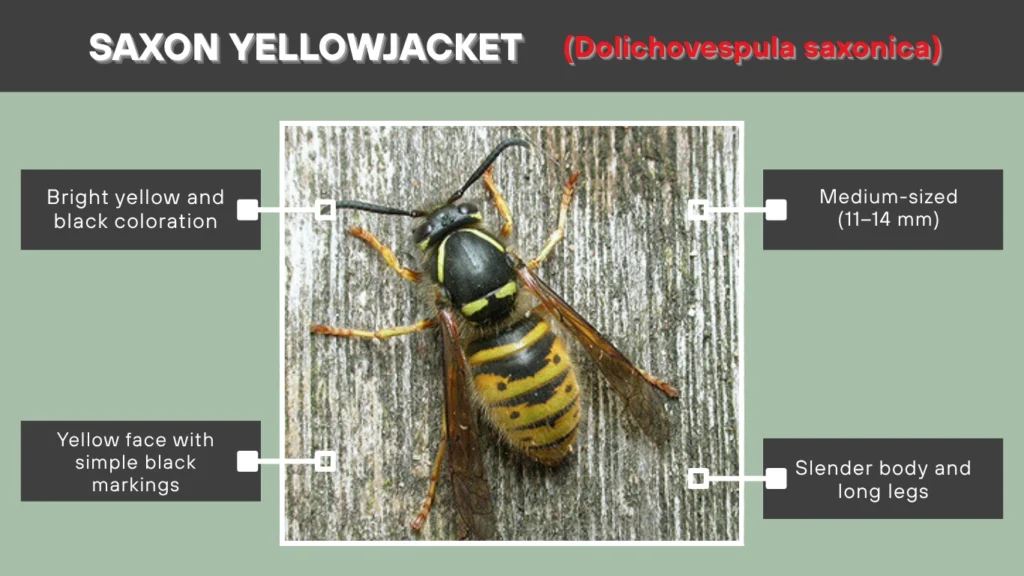
The Saxon Yellowjacket is native to Europe but has been spreading to other parts of the world. It typically builds aerial nests in residential areas.
Identification
- Bright yellow and black coloration
- Yellow face with simple black markings
- Medium-sized (11–14 mm)
- Slender body and long legs
- Subtle differences from D. arenaria
Behavior and Nesting
Saxon Yellowjackets build large paper nests in trees, attics, or on buildings. They are highly adaptive and often thrive in human environments.
Sting Risk and Aggression
They can become aggressive if the nest is approached. Stings are painful and may lead to allergic reactions in sensitive individuals.
16. Median Wasp (Dolichovespula media)

The Median Wasp is a European species that’s growing in population and has been seen in parts of Asia. It’s slightly larger and less aggressive than other yellowjackets.
Identification
- Yellow and black stripes with a reddish tint
- Yellow face with limited black markings
- Larger size (14–18 mm)
- Long body and narrow waist
- Often mistaken for hornets due to size
Behavior and Nesting
They build aerial nests in hedges, trees, or under roofs. Colonies are moderate in size and typically active from late spring to early fall.
Sting Risk and Aggression
Less aggressive compared to other yellowjackets. Stings are uncommon unless the nest is physically disturbed. Suitable for coexistence if undisturbed.
FAQs
How many species of yellow jacket wasps exist?
There are over 16 commonly recognized yellow jacket wasp species, mainly from the Vespula and Dolichovespula genera. Some build underground nests, while others create aerial nests.
Are all yellowjackets aggressive?
Most yellowjackets are aggressive if their nest is disturbed, especially ground-nesting species like the Eastern or Southern Yellowjacket. Some aerial species like the Median Wasp are less aggressive.
Which yellowjacket is the most dangerous to humans?
The Southern Yellowjacket (Vespula squamosa) is considered one of the most aggressive and dangerous, especially when forming large, perennial colonies in warm climates.
Do yellowjackets die after stinging like honeybees?
No. Yellowjackets can sting multiple times because their stingers are not barbed. This makes them especially dangerous when defending their nests.
What’s the difference between Vespula and Dolichovespula wasps?
Vespula species usually build underground nests and are more aggressive scavengers. Dolichovespula species typically build aerial nests and are slightly less aggressive.
